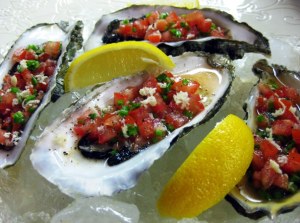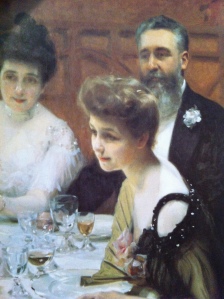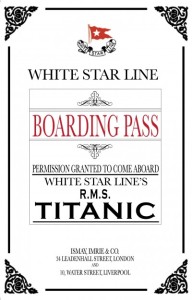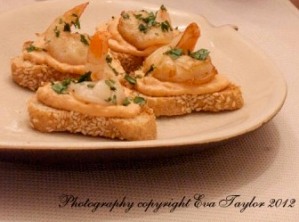Tags
Downton Abbey Food, Downton Abbey Party Food, Downton Abbey recipes, Titanic Menus, Titanic recipes
April 14th marks the 100th anniversary of the sinking of the Titanic. On Sunday, April 14, 1912 at 11:40 pm, Titanic struck a giant iceberg and by 2:20 am on April 15, the “unsinkable ship” was gone. Canadians have a special connection to Titanic: the great ship sank in the chilly waters south of Newfoundland, and Canadian vessels were involved in the recovery efforts. Over 100 victims of the Titanic are buried in the Fairview Cemetery in Halifax.
The fictional Crawley family suffered the loss of two heirs on Downton Abbey; in reality many of the wealthiest families in America were affected. Far worse were those in third class. Whole families had been traveling together to American to start a new life.Titanic’s story is appealing on many different levels. Social historians use this specific point in time to demonstrate life in the Edwardian world, with its strict class distinctions, and the charmed life of the aristocracy who were obsessed with etiquette and love of fine food. Like Titanic, class distinctions would be splinted by World War I. Over the next month I will be focusing on various aspects of the lifestyles of both upper and lower classes.
I well remember that last meal on the Titanic. We had a big vase of beautiful daffodils on the table, as fresh as if they had just been picked. Everybody was gay, and people were making bets on the probable time of this record breaking voyage. First class passenger Lady Duff-Gordon
Titanorak alert
Titanoraks are those people obsessed with every detail of Titanic. They normally stick to themselves but for they will be out in droves for the centennial. In case of an encounter, arm yourself with knowledge: this link provides some of the best Titanic sources.
Julian Fellowes happens to be one of the most famous of the bunch. His Downton Abbey story lines are directly tied to the Titanic sinking. His upcoming Titanic four part mini-series might best be described as “Downton at Sea”, continuing the interactions of the social classes. A large portion of its audience will likely be Downton fans anxiously awaiting Season 3.
Titanic the Mini-Series vs. Titanic the Movie
Luke Jones had the privilege of pre-screening two segments of the new mini-series for Huffington Post. The Good news is that the cliches are limited to the obvious, and promises to deliver the same sort of snide quips that Downton is known for: “I’d rather freeze to death outside than stand here with these ghastly women” and “some of them look suspiciously like Catholics”. The sad news is that we will have to endure the sinking of the ship at the end of every episode, each told from a different perspective. In the final installment we will find out who survives. I was pleased that Luke mentioned Maria Doyle Kennedy’s performance. Downton fans will remember her as Mr. Bates’ evil wife; it sounds like she has landed a substantive role in this drama.
Check your local listings, but I understand that Titanic will air on ABC in the US, with 3 installments on April 13, the finale on April 14th. In Canada, the series will run weekly starting on March 21st on Global TV in the Toronto area.
Dining with the Astors
The most well known passenger was Colonel John J. Astor, the richest man in America at that time. We discussed at the outset that upper classes were obsessed with proper etiquette and rituals as a way of enforcing class distinction. You may find inspiration from some of these rituals for your own Titanic Tribute.
- A bugler called the passengers to dinner with the tune “The Roast Beef of Old England”.
- The gentleman offered his right arm to his lady and escorted her to her place, which was always to his right, held her chair for her then sat down himself.
- Edwardian menus were greatly influenced by the elaborate and heavily sauced cuisine by noted French Master Auguste Escoffier.
- As you can tell from the 1st class menu, the variety allowed one to eat as little or as such as he or she liked. While Edwardians had legendary appetites, it is likely that much food was left on their plates.
- Titanic loaded 1,221 quarts of oysters when it left Southampton and was a staple in first class.
- The common after dinner custom was to divide the gentlemen and ladies, the former to smoke cigars, the latter gathering for coffee, cordials or port.
The Titanic Tribute Dinner Menus and Recipes: A Recap
Over the last few months we have been steadily working through Titanic menus and recipes. If you are planning a tribute dinner you should already be deep in planning. My talented friend Eva prepared invitations for her friend’s upcoming party. She blogs about food at Kitcheninspirations, but she is also a very talented graphic designer. I am partial to her work, particularly since she designed our wedding invitations.Testing dishes is also an important part of the process. I have used actual Titanic menus and Last Dinner on the Titanic as guides. The book not only lists recipes for the specific dishes mentioned, but provides alternative dishes popular at that time.
Here is a list of all the dishes from all 3 menus:
- Titanic Menus
- Appetizers
- Canapés à L’Amiral (see below)
- Oysters à la Russe (see below)
- Soups
- Main Course
- Side Dishes
- Palate Cleansers
- Desserts
- Medicinal
The First Course in 1st Class
The actual 1st class menu doesn’t describe the first course in detail, other than to indicate “hors d’ouevre variés” and “oysters”. Titanorak foodies have contented themselves with agreeing on Canapés à L’Amiral, an Escoffier standard. If you wish to explore other possibilities, you may wish to consult a classic French cookbook.
Eva not only designed the invitations above, but is offering some help with the food. She recently tested the canapé recipe, and was kind enough to share a photo.
Canapés à L’Amiral
from Last Dinner on the Titanic
Makes 20 hors d’oeuvres
Ingredients:
- 1/2 thin baguette
- 1 tsp. lime juice
- 10 small shrimp, halved lengthwise, cooked
- Fresh flat-leaf parsley
- 2 tbsp. fish roe (while caviar was likely used on Titanic, flying fish roe/tapiko has great color, taste and is less expensive)
SHRIMP BUTTER
- 1 tablespoon vegetable oil
- 1 large shallot, minced
- 1 clove garlic, minced
- 8 oz. shrimp in shell
- 1/4 cup brandy
- 4 oz. cream cheese, softened
- 2 tablespoons. butter, softened
- 1 tablespoon tomato paste
- 1/4 teaspoon each salt and pepper
- Dash vanilla
Method
- In skillet, heat oil over medium heat; add shallot and garlic; cook, stirring often, for 5 minutes or until softened.
- Increase heat to high, add shrimp and sauté, stirring, for 3 to 4 minutes or until shells are pink and flesh is opaque.
- Transfer shrimp and vegetables to bowl of food processor. Return pan to stove and pour in brandy; cook, stirring, for 30 seconds or until brandy is reduced to a glaze; scrape into shrimp mixture.
- Puree shrimp mixture until finely chopped. Add cream cheese, butter, tomato paste, salt, pepper, and vanilla. Process until almost smooth. Press shrimp mixture through coarse sieve set over bowl; discard shells.
- Slice baguette into 20 thin slices. Place on baking sheet and toast under broiler for 1 minute per side or until lightly golden. Reserve.
- Drizzle lime juice over cooked shrimp halves; stir and reserve.
- Place shrimp butter in piping bag fitted with star tube. Pipe shrimp butter onto toasts. Alternatively, use a table knife to spread on to the toast.
- Top with a cooked shrimp half and a parsley leaf.
- Top each canapé with an equal amount of fish roe.
Oysters a la Russe

A colorful addition to your table, photo from fellow Canadian foodie at www.thedragonskitchen.com
Serves 6
Ingredients
- 2 tablespoons vodka
- 1/2 teaspoon lemon juice
- 1/4 tsp. prepared horseradish (I added a little more)
- Dash hot pepper sauce
- Pinch salt
- Pinch sugar
- 1 plum tomato, seeded and finely chopped
- 1 tbsp. chives, finely chopped
- 12 large oysters
- Coarsely cracked black peppercorns
Method
- In bowl, stir together vodka, lemon juice, horseradish, hot pepper sauce, sugar, salt.
- Gently stir in tomato and chives.
- Wash oysters under running water to remove any loose barnacles or sand.
- Insert tip of oyster shucker between shell halves near hinges; twist upward to open shell. Discard top shell, Using blade of shucker, sever connective membrane that holds oyster to bottom shell. Place open oysters on bed of shaved or crushed ice.
- Spoon vodka relish over each oyster; dusting with cracked pepper.





Thanks for the shout out and kind words, Pamela. I am really looking forward to my friend’s party. I just ordered a tuxedo tail for JT and I’m borrowing a gorgeous lace dress from my friend Monica!
I’m helping out with two dishes for the party, the shrimp canapé that you show above and a dessert. I am a little surprised with the recipes I’ve made thus far, that they are somewhat bland…but I will preserver and stick to the recipe so that it is authentic. I hope you stop by the blog again, I’ve made a chicken liver paté that I will be blogging about later this week!
While visiting Denmark last April, I had the opportunity to attend the traveling exhibit in memory of the 100th Anniversary of the Titantic sinking. It was both a fascinating and sad experience.
Pingback: Game Plan for Hosting a 1st Class Titanic Tribute Dinner « Downton Abbey Cooks
Pingback: Downton Viewing Party- What might Mrs. Patmore serve? Eton Mess « Downton Abbey Cooks
Pingback: Downton Abbey Cook’s Tea Tuesday: Your Online Guide to Afternoon Tea « Downton Abbey Cooks
Thanks for the post this is exactly what I needed to read.
Pingback: Canapes a L’Amirals | Living Romantically